The lat pulldown, also known as the “cable lat pulldown,” is a compound back exercise that involves pulling a weight from above your head to your chest.
It closely resembles the pull-up, only instead of pulling your body up to a bar, you’re pulling a bar down to your body.
Although these exercises offer similar benefits, the lat pulldown has a few advantages over the pull-up that make it a worthwhile exercise, especially if you’re new to weightlifting.
In this article you’ll learn the benefits of the lat pulldown, as well as which muscles are worked in the lat pulldown, how to do the lat pulldown with proper form, and how to do some of the best lat pulldown variations, including the close-grip lat pulldown, the wide-grip lat pulldown, the straight-arm lat pulldown, and more!
Table of Contents
+
Lat Pulldown: Benefits
1. It trains the entire back.
Given its name, most people think of the lat pulldown as a lat exercise. However, research shows that the lat pulldown effectively trains more or less all of your back muscles, as well as many of the smaller muscles of the shoulders, biceps, and forearms, too.
This is beneficial for two reasons:
- You can effectively train your entire back with one exercise instead of doing several different exercises to train each muscle group.
- You can use heavy weights (because the lat pulldown involves almost every major muscle group in your back), which makes it ideal for gaining muscle and strength.
2. It’s highly adaptable.
Most gyms have several different lat pulldown attachments you can use with the lat pulldown machine that allow you to vary your grip while performing the exercise. The most common variations are the . . .
- Medium-grip lat pulldown, which involves a pronated (palms facing away from you) grip just outside of shoulder-width apart
- Wide-grip lat pulldown, which involves a pronated grip roughly double-shoulder-width apart
- Reverse-grip lat pulldown, which involves a supinated (palms facing you) grip about shoulder-width apart
- Close-grip lat pulldown, which involves using a V-bar lat pulldown attachment that places your hands about 6-to-8 inches apart with your palms facing each other
Although you’ll often hear people say that one variation is much better at training a particular muscle group than the others (for instance, many believe that the wide-grip lat pulldown is the best for training your lats), research shows this is false.
Instead, all of these variations train most of your back and arm muscles about equally well, and it doesn’t much matter which one you use in your training. Thus, I recommend you experiment with different variations and use the one(s) that feels most comfortable to you.
Personally, I prefer the medium-grip pronated lat pulldown, but I also sometimes use the close-grip lat pulldown when the former gets stale.
3. It’s easy to learn and progress.
When it comes to “vertical pulling” exercises (exercises that involve pulling something from above your head toward your body), most people think the pull-up and chin-up reign supreme.
This isn’t wrong—the pull-up and chin-up are among the best back exercises you can do—but they’re not always a great place to start if you’re new to weightlifting. That’s because the pull-up and chin-up are notoriously hard, and if you’re new to weightlifting or overweight, you may not be strong enough to complete a single rep.
The lat pulldown trains almost the same muscles as the pull-up and chin-up, but it’s easier to learn and allows you to use lighter weights and build your strength over time. This makes it ideal for people who are overweight or just starting out in their weightlifting journeys.
This doesn’t mean it’s ineffective for more advanced weightlifters, though.
Regardless of how fit you are, the pull-up and chin-up are challenging exercises, and doing enough volume for your lats and traps each week using these exercises alone can be a grind.
The lat pulldown is less demanding on your body yet still trains your back muscles to a similar degree, which means you can use it to train your back with more sets and reps each week without wearing yourself to a frazzle.
Lat Pulldown: Muscles Worked
The lat pulldown trains nearly all of your back muscles, including the:
- Latissimus dorsi
- Teres major and minor
- Infraspinatus
- Rhomboids
- Trapezius
- Posterior deltoid
It also stimulates the biceps, forearms, pecs, and many of the smaller shoulder muscles to a lesser degree, too.
Here’s how the main muscles worked by the lat pulldown look on your body:
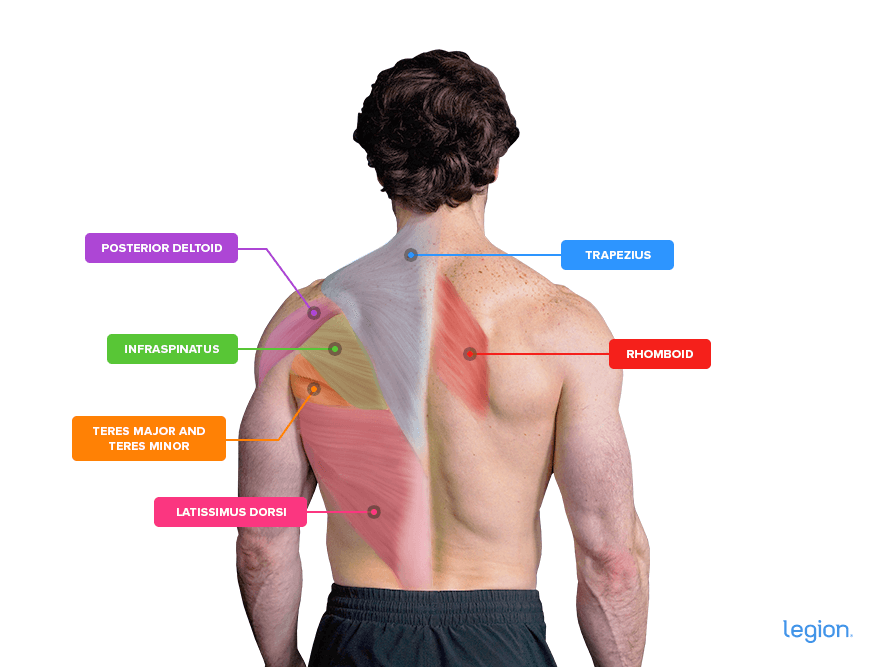
How to Do the Lat Pulldown
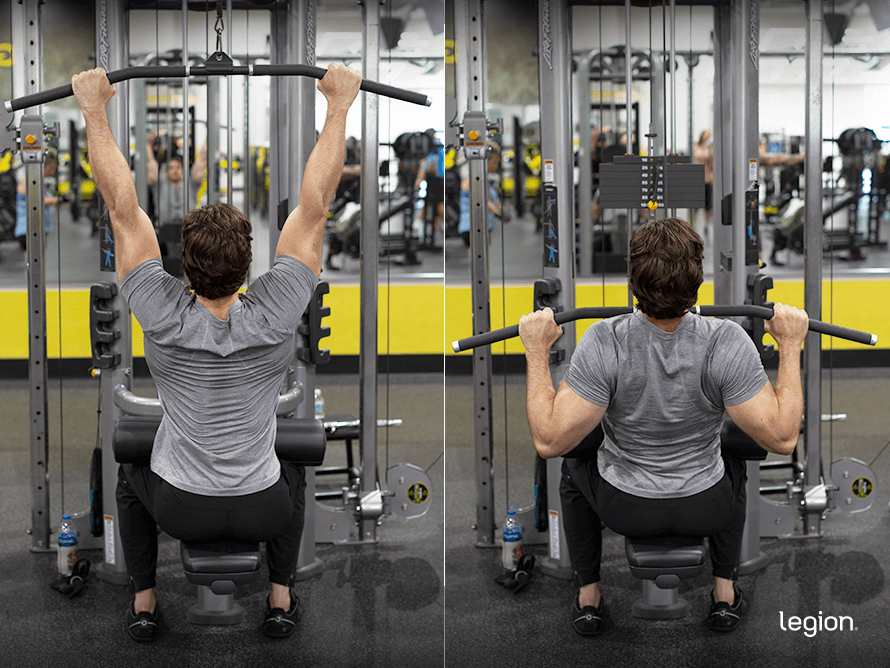
The best way to learn how to do the lat pulldown is to break it into three parts: set up, pull, and ascend.
Step 1: Set up
Sit on a lat pulldown machine seat and adjust the thigh pad so that it locks your lower body in place, then slide your thighs out, stand up, and grab the bar with a slightly wider than shoulder-width grip and your palms facing away from you.
While keeping your grip on the bar and your arms straight, sit down, allowing your body weight to pull the bar down with you. Nudge your thighs under the thigh pads and plant your feet flat on the floor.
Step 2: Pull
Sit up straight with your chest proud and a slight arch in your lower back, then tuck your shoulder blades down and squeeze them together (a good cue for this is to think of pulling your shoulder blades into your back pockets).
Without generating momentum by whipping your torso backward, pull the bar toward your chest until the bar is underneath your chin (or touches your chest, if you want to make the exercise harder). (Tip: imagine trying to pull your elbows into the floor.)
Step 3: Ascend
Reverse the movement to return the bar to its starting position above your head. This is basically a mirror image of what you did during the pull.
Here’s how it should look when you put it all together:
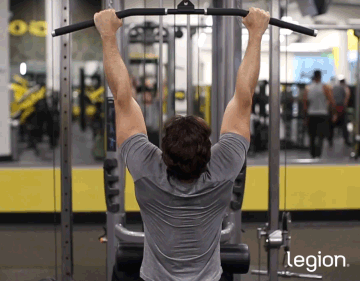
Lat Pulldown: Variations
1. Close-Grip Lat Pulldown
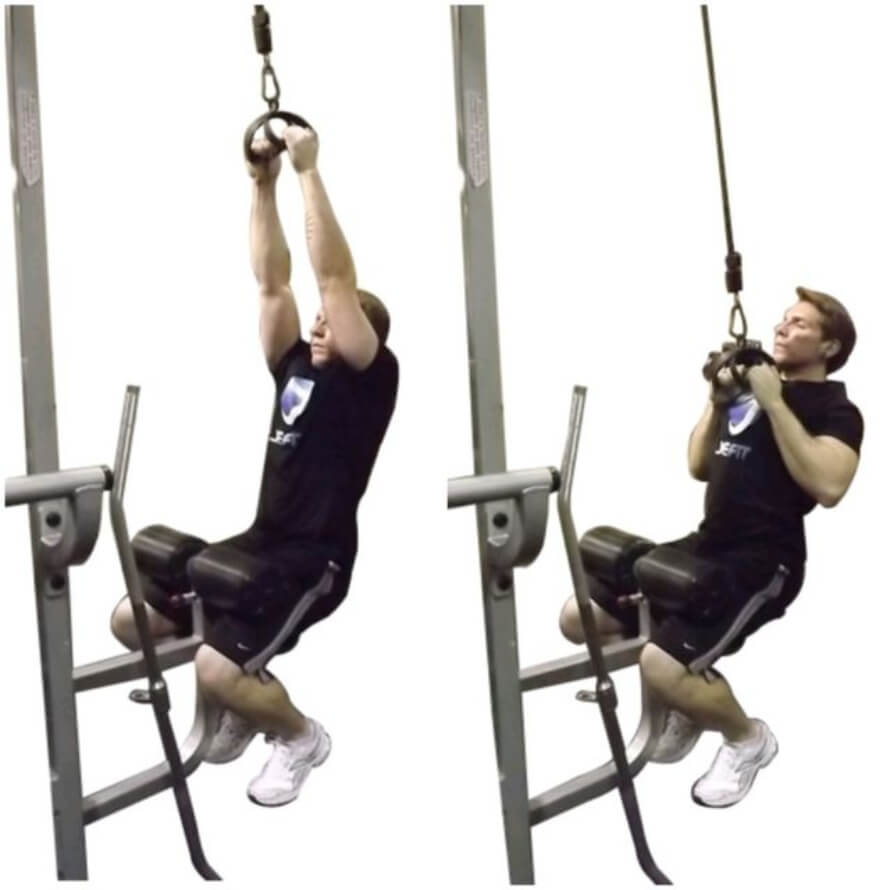
The close-grip lat pulldown (also known as the “narrow-grip lat pulldown” or “V-bar lat pulldown”) places your hands in a neutral position (palms facing each other) which gives you a mechanical advantage, allowing you to lift more weight. Many people also find this more comfortable than regular lat pulldowns, or, like me, see it as an enjoyable and equally effective alternative.
How to:
- Adjust the thigh pad of a lat pulldown machine so that it locks your lower body in place.
- Stand up and grab the V-bar handles.
- While keeping your grip on the V-bar and your arms straight, sit down, allowing your body weight to pull the bar down with you.
- Nudge your thighs under the thigh pads and plant your feet flat on the floor.
- Pull the handle toward your chest. Once the handle is underneath your chin (or touches your chest, if you want to make the exercise harder), reverse the movement to return to the starting position. (Tip: a helpful cue for this exercise is to imagine pulling your elbows into the floor).
2. Wide-Grip Lat Pulldown

Despite what many people say, research shows that the wide-grip lat pulldown (sometimes simply called the “wide lat pulldown”) is not better than the standard lat pulldown for training your lats. That said, some people prefer it because it helps them create a strong mind-muscle connection with the muscles they want to train.
How to:
- Adjust the thigh pad of a lat pulldown machine so that it locks your lower body in place.
- Stand up and grab the bar your palms facing away from you and about twice your shoulder width apart.
- While keeping your grip on the bar and your arms straight, sit down, allowing your body weight to pull the bar down with you.
- Nudge your thighs under the thigh pads and plant your feet flat on the floor.
- Pull the bar toward your chest. Once the bar is underneath your chin (or touches your chest, if you want to make the exercise harder), reverse the movement to return to the starting position.
3. Straight-Arm Lat Pulldown
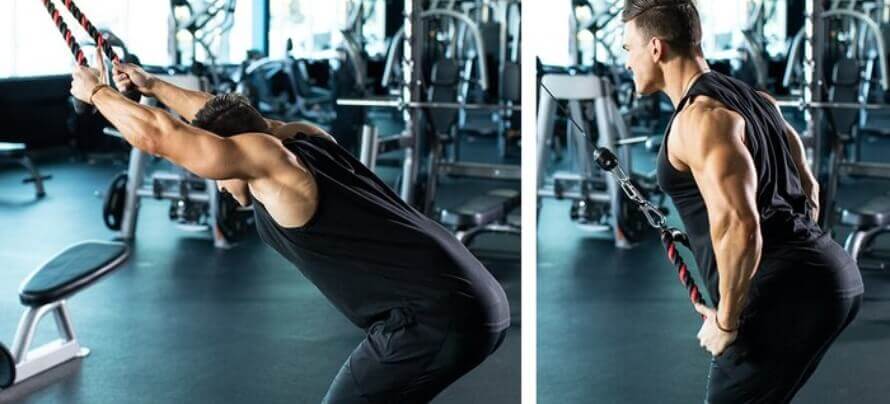
The main benefit of the straight-arm lat pulldown (also known as the “standing lat pulldown”) is that it greatly emphasizes your lats. This makes it a great exercise if your arms are already smoked from, say, pull-ups, but you feel your lats could still benefit from a few more sets.
How to:
- Set the pulley to the highest position on a cable pulley machine and attach a rope handle.
- Grip one end of the rope in each hand and take a few steps away from the pulley so that there’s tension in the cable.
- Lean forward so that your body is at about a 45-degree angle relative to the floor. Your arms should be straight and stretched over your head.
- Without bending your elbows, pull the rope in an arc toward your feet so that your hands end up at your thighs, then reverse the movement to return to the starting position.
4. Single-Arm Lat Pulldown
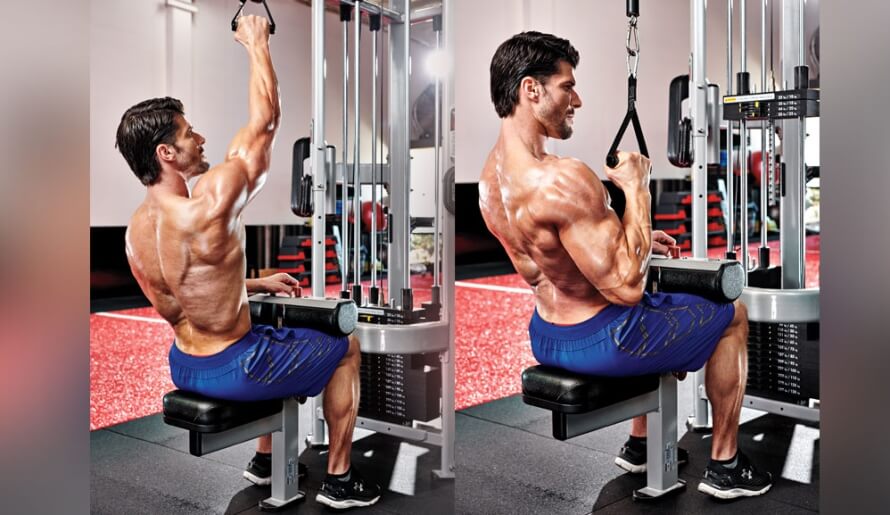
The single-arm lat pulldown (also known as the “one-arm lat pulldown”) allows you to train each side of your body independently, which is useful for identifying and evening out any muscle or strength imbalances you might have.
How to:
- Attach a single handle attachment to the lat pulldown machine then adjust the thigh pad so that it locks your lower body in place.
- Stand up and grab the handle in your right hand with your thumb pointing toward your head.
- While keeping your grip on the handle and your right arm straight, sit down, allowing your body weight to pull the handle down with you.
- Nudge your thighs under the thigh pads and plant your feet flat on the floor.
- Pull the handle toward your chest. Once the handle is underneath your chin, reverse the movement to return to the starting position.
- Once you’ve completed the desired number of reps, switch sides and repeat the process with your left arm.
5. Reverse-Grip Lat Pulldown
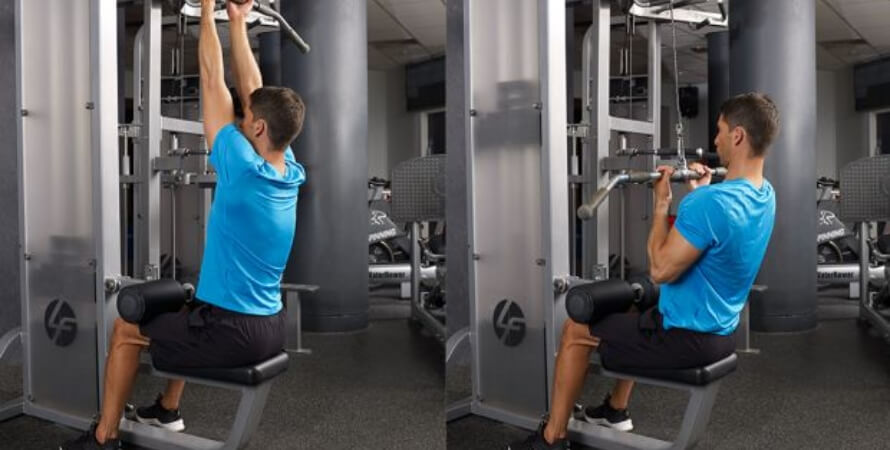
The reverse-grip lat pulldown (also known as the “underhand lat pulldown,” “supinated lat pulldown,” or “reverse lat pulldown”) trains the back in a very similar way to the standard lat pulldown. The only difference is the standard lat pulldown may train the lats slightly more than the reverse-grip lat pulldown, while the reverse-grip lat pulldown may train the biceps slightly more than standard lat pulldown (similar to the relationship between a pull-up and a chin-up).
How to:
- Adjust the thigh pad of a lat pulldown machine so that it locks your lower body in place.
- Stand up and grab the bar with a shoulder-width grip and your palms facing toward you.
- While keeping your grip on the bar and your arms straight, sit down, allowing your body weight to pull the bar down with you.
- Nudge your thighs under the thigh pads and plant your feet flat on the floor.
- Pull the bar toward your chest. Once the bar is underneath your chin (or touches your chest, if you want to make the exercise harder), reverse the movement to return to the starting position.
6. Neutral-Grip Lat Pulldown
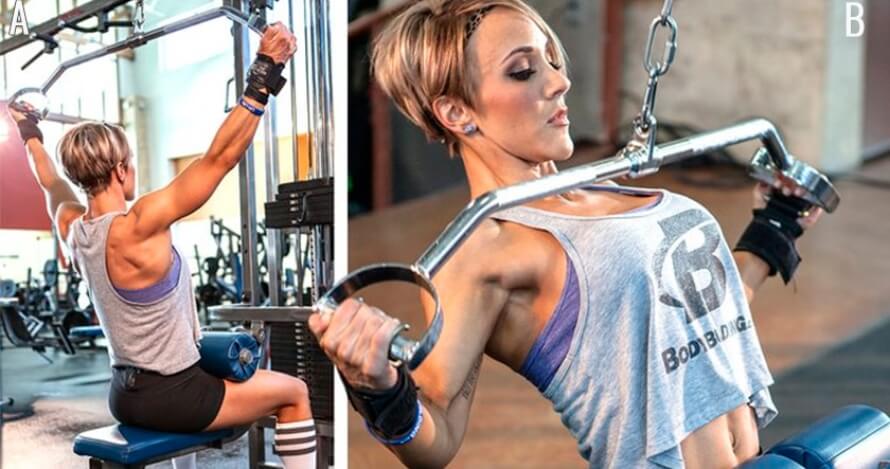
The neutral-grip lat pulldown is a viable alternative to the standard lat pulldown because it trains your back in a similar way. That said, most people find they can lift less weight with the neutral-grip lat pulldown than with other variations, and some people find it uncomfortable for their shoulders.
How to:
- Attach the neutral-grip attachment to a lat pulldown machine and adjust the thigh pad so that it locks your lower body in place.
- Stand up and grab the bar by the handles with your palms facing each other.
- While keeping your grip on the handles and your arms straight, sit down, allowing your body weight to pull the bar down with you.
- Nudge your thighs under the thigh pads and plant your feet flat on the floor.
- Pull the bar toward your chest. Once the bar is underneath your chin (or touches your chest, if you want to make the exercise harder), reverse the movement to return to the starting position.
8. Banded Lat Pulldown
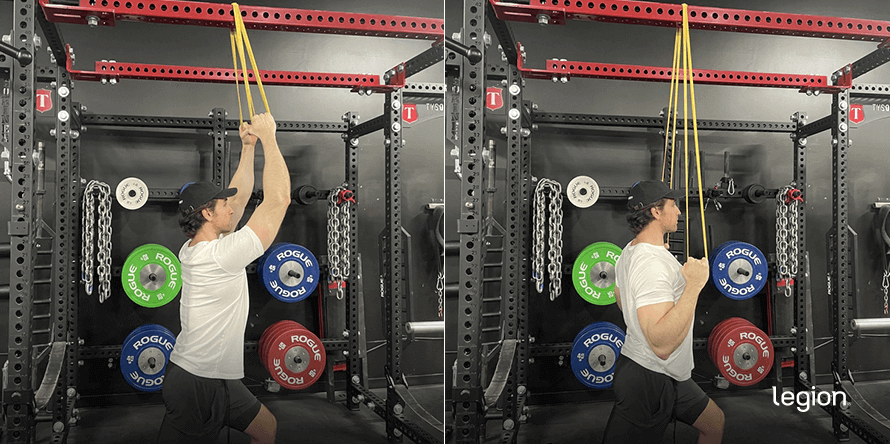
The banded lat pulldown is a good lat pulldown variation if you’re very new to weightlifting, coming back from an injury and taking it easy, or if you’re traveling or training in a home gym and don’t have access to a lat pulldown machine.
How to:
- Wrap a resistance band around a pull-up bar, attic rafter, or some other point several feet above your head.
- Hold one end of the band in each hand and walk backward, allowing your arms to straighten, until all of the slack is out of the band.
- Pull both ends of the band straight down until your hands are below your chin.
- Reverse the movement to return to the starting position.
FAQ #1: What’s the best lat pulldown bar or lat pulldown attachment?
No lat pulldown bar or lat pulldown attachment is inherently better than any other.
Choose whatever lat pulldown bar or attachment is most comfortable for you and allows you to use the greatest range of motion and heaviest weights. For most people, this is either the medium-grip pronated lat pulldown using a straight bar or the close-grip lat pulldown, although some people also like the reverse-grip, single-arm, and straight arm variations.
FAQ #2: Can you do a lat pulldown with dumbbells?
No.
That said, exercises like the one-arm dumbbell row and the dumbbell pullover are both effective back exercises that train many of the same muscle groups as the lat pulldown that you can do with dumbbells.
FAQ #3: Lat Pulldown vs. Pull-up: What’s better?
It depends.
The lat pulldown and pull-up are both effective exercises for training all the muscles of the back, though the pull-up is probably slightly better at training secondary muscle groups such as the biceps and abs (yes, really).
That said, many people aren’t strong enough to do a pull-up or chin-up, which makes the lat pulldown a better stopgap exercise until they develop more upper body strength. The pull-up and chin-up are also very taxing, which can make the lat pulldown a better exercise for including at the end of your workout when you’re already shagged.
FAQ #4: What’s the best power rack with a lat pulldown?
If you’re looking to buy a power rack with a lat pulldown, check out the Rogue RM-3 Monster Rack with the rack-mounted Monster Lat Pulldown and Low Row machine.
It’s one of the sturdiest designs out there, and features high quality cables and pulleys that won’t wear out (which is the main problem with lat pulldown machines). It also lets you do cable rows, which are another excellent back exercise.
FAQ #5: How can I do a lat pulldown at home?
Unless you have a lat pulldown machine or a power rack with a lat pulldown, you can’t.
If you don’t have a lat pulldown machine or a power rack with a lat pulldown, the best alternatives are the pull-up and chin-up.
FAQ #6: Is the behind-the-neck lat pulldown a good variation?
Studies show that the behind-the-neck lat pulldown is no more effective for training the lats than the “front lat pulldown,” but because of the technique that’s involved, it’s more likely to irritate your shoulders.
Thus, it’s best to avoid the behind-the-neck lat pulldown and choose a different lat pulldown variation from the list above instead.
Scientific References +
- Franke, R., Botton, C. E., Rodrigues, R., & Pinto, R. S. (n.d.). (PDF) Analysis of anterior, middle and posterior deltoid activation during single and multijoint exercises. Retrieved January 19, 2022, from https://www.researchgate.net/publication/263292517_Analysis_of_anterior_middle_and_posterior_deltoid_activation_during_single_and_multijoint_exercises
- Joseph F Signorile, Attila J Zink, & Steven P Szwed. (n.d.). A comparative electromyographical investigation of muscle utilization patterns using various hand positions during the lat pull-down - PubMed. Retrieved January 19, 2022, from https://pubmed.ncbi.nlm.nih.gov/12423182/
- Lusk, S. J., Hale, B. D., & Russell, D. M. (2010). Grip width and forearm orientation effects on muscle activity during the lat pull-down. Journal of Strength and Conditioning Research, 24(7), 1895–1900. https://doi.org/10.1519/JSC.0B013E3181DDB0AB
- Andersen, V., Fimland, M. S., Wiik, E., Skoglund, A., & Saeterbakken, A. H. (2014). Effects of grip width on muscle strength and activation in the lat pull-down. Journal of Strength and Conditioning Research, 28(4), 1135–1142. https://doi.org/10.1097/JSC.0000000000000232
- Lehman, G. J., Buchan, D. D., Lundy, A., Myers, N., & Nalborczyk, A. (2004). Variations in muscle activation levels during traditional latissimus dorsi weight training exercises: An experimental study. Dynamic Medicine : DM, 3, 4. https://doi.org/10.1186/1476-5918-3-4
- Andersen, V., Fimland, M. S., Wiik, E., Skoglund, A., & Saeterbakken, A. H. (2014). Effects of grip width on muscle strength and activation in the lat pull-down. Journal of Strength and Conditioning Research, 28(4), 1135–1142. https://doi.org/10.1097/JSC.0000000000000232
- Lehman, G. J., Buchan, D. D., Lundy, A., Myers, N., & Nalborczyk, A. (2004). Variations in muscle activation levels during traditional latissimus dorsi weight training exercises: An experimental study. Dynamic Medicine : DM, 3, 4. https://doi.org/10.1186/1476-5918-3-4
- Doma, K., Deakin, G. B., & Ness, K. F. (2013). Kinematic and electromyographic comparisons between chin-ups and lat-pull down exercises. Sports Biomechanics, 12(3), 302–313. https://doi.org/10.1080/14763141.2012.760204
- Youdas, J. W., Amundson, C. L., Cicero, K. S., Hahn, J. J., Harezlak, D. T., & Hollman, J. H. (2010). Surface electromyographic activation patterns and elbow joint motion during a pull-up, chin-up, or perfect-pullupTM rotational exercise. Journal of Strength and Conditioning Research, 24(12), 3404–3414. https://doi.org/10.1519/JSC.0B013E3181F1598C
- Hewit, J. K., Jaffe, D. A., & Crowder, T. (2018). J Phy Fit Treatment & Sports A Comparison of Muscle Activation during the Pull-up and Three Alternative Pulling Exercises. J Phy Fit Treatment & Sportsl, 5(4). https://doi.org/10.19080/JPFMTS.2018.05.555669
- Sperandei, S., Barros, M. A. P., Silveira-JÚnior, P. C. S., & Oliveira, C. G. (2009). Electromyographic analysis of three different types of lat pull-down. Journal of Strength and Conditioning Research, 23(7), 2033–2038. https://doi.org/10.1519/JSC.0B013E3181B8D30A
- Pagnani, M. J., & Warren, R. F. (1994). Stabilizers of the glenohumeral joint. Journal of Shoulder and Elbow Surgery, 3(3), 173–190. https://doi.org/10.1016/S1058-2746(09)80098-0
- Durall, C. J., Manske, R. C., & Davies, G. J. (2001). Avoiding Shoulder Injury from Resistance Training. Strength and Conditioning Journal, 23(5), 10–18. https://doi.org/10.1519/00126548-200110000-00002










